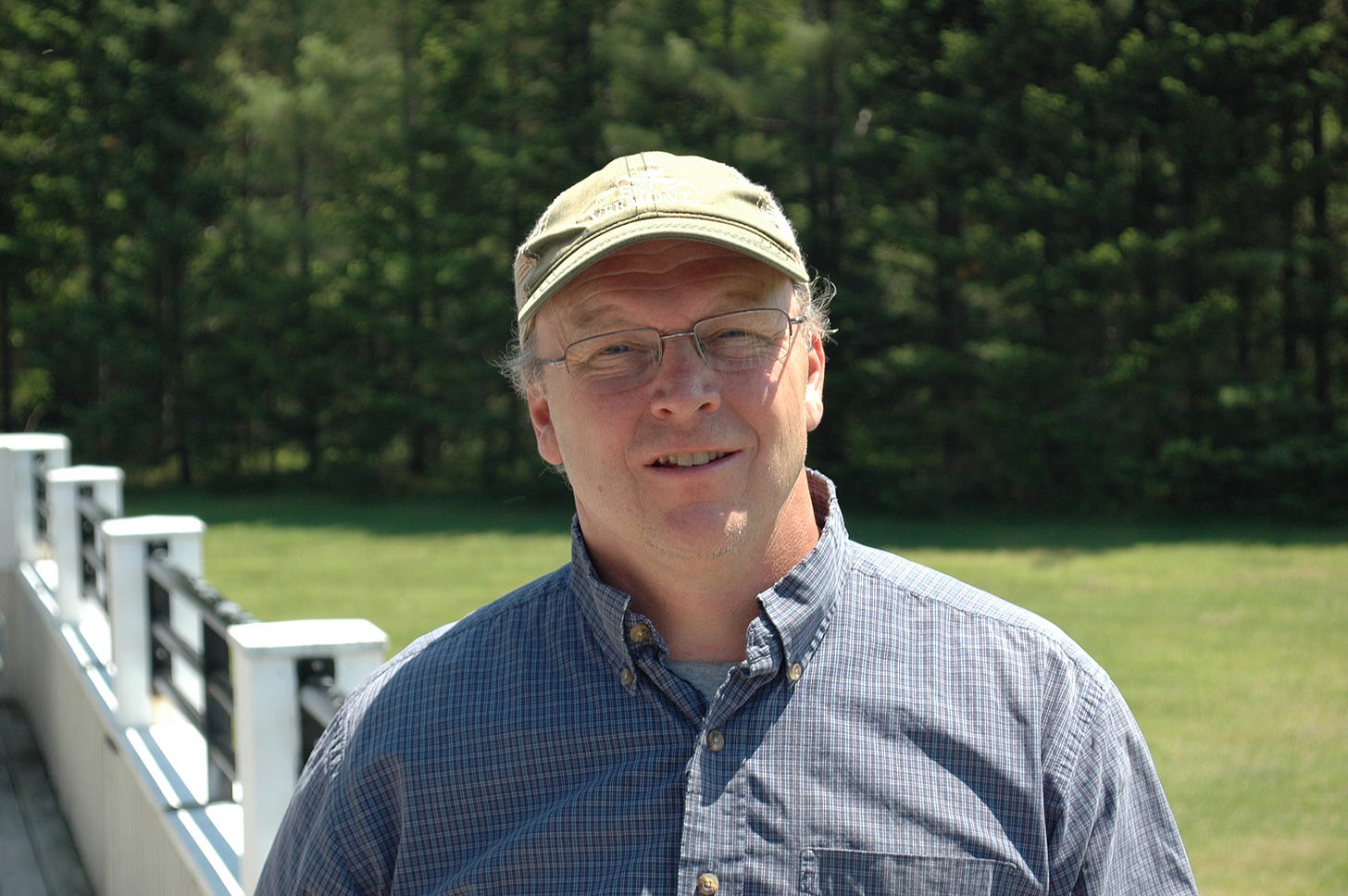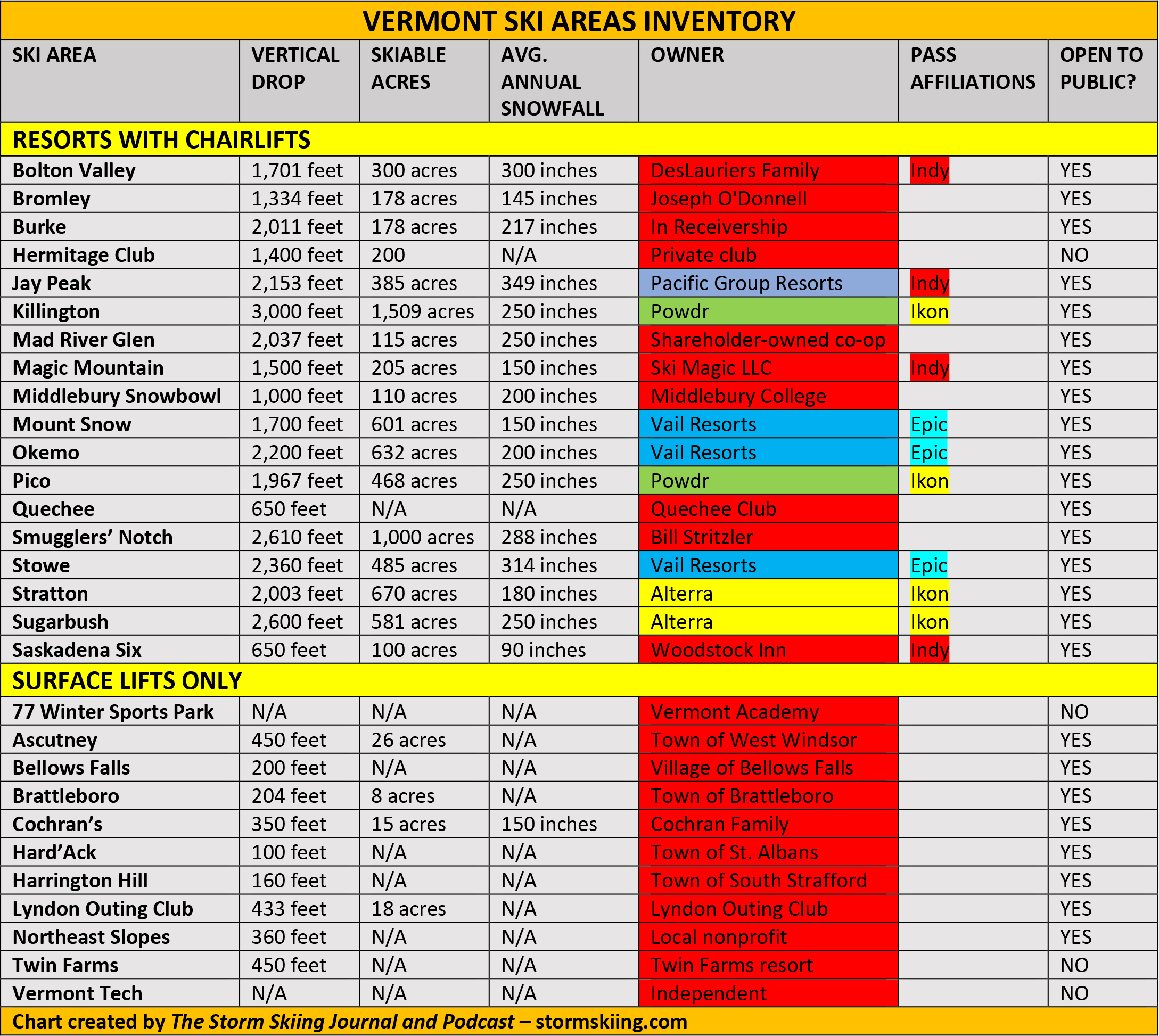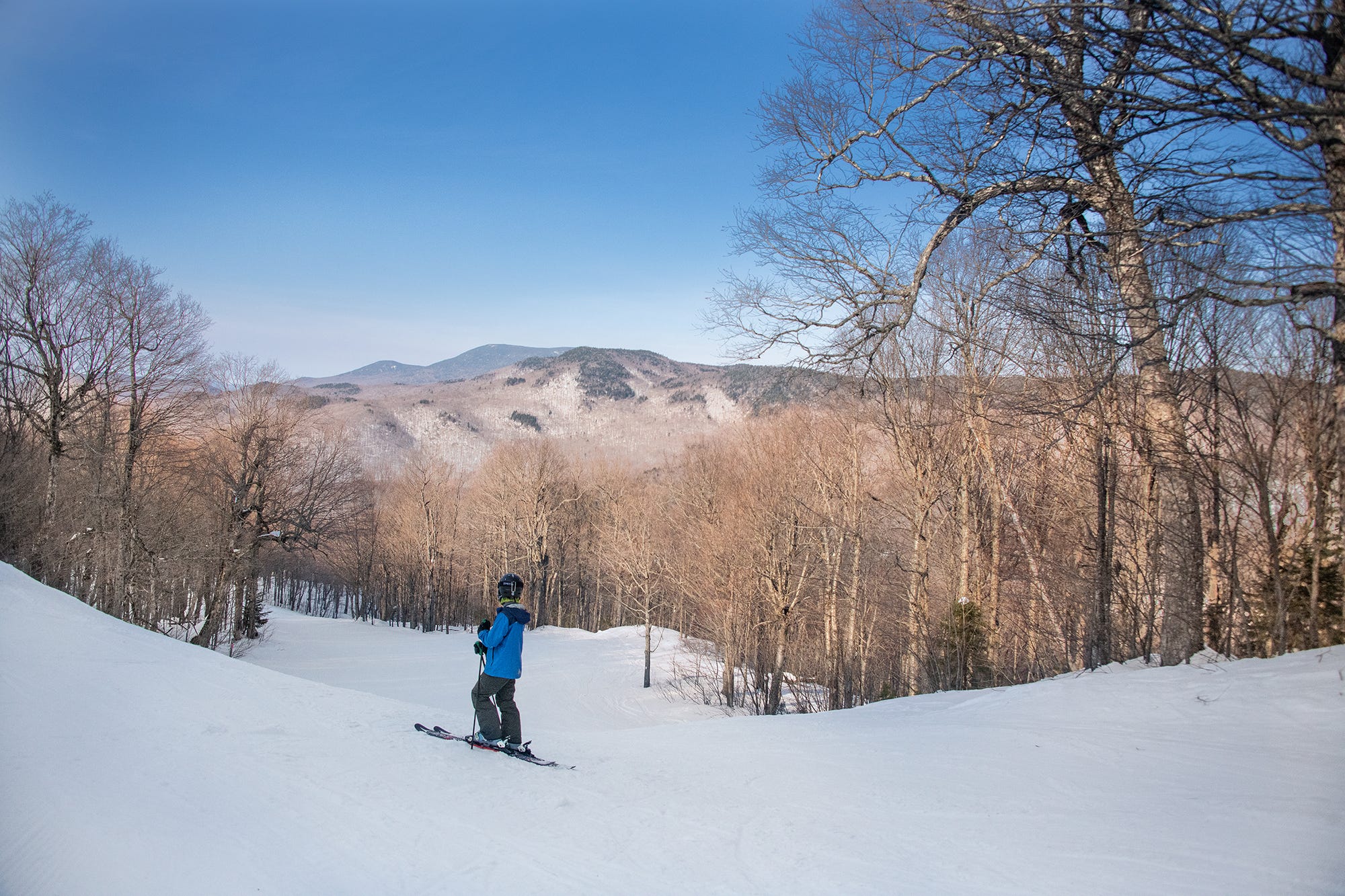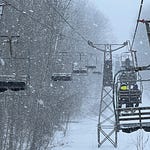Who
Mike Hussey, General Manager of Middlebury College Snowbowl, Vermont
Recorded on
May 15, 2023
About Middlebury Snowbowl
Click here for a mountain stats overview
Owned by: Middlebury College
Located in: Hancock, Vermont
Year founded: 1936
Pass affiliations: Indy Pass Allied Resort
Reciprocal partners: None
Closest neighboring ski areas: Sugarbush (38 minutes), Mad River Glen (43 minutes), Pico (45 minutes), Killington (49 minutes)
Base elevation: 1,720 feet
Summit elevation: 2,720 feet
Vertical drop: 1,000 feet
Skiable Acres: 100 on-trail; 600+ woods and glades
Average annual snowfall: 200 inches
Trail count: 17 (8 advanced/expert, 4 intermediate, 5 beginner) + 11 glades
Lift count: 4 (1 fixed-grip quad [to replace Sheehan double for 2023-24 ski season], 2 triples, 1 carpet – view Lift Blog’s inventory of Middlebury Snowbowl’s lift fleet)

Why I interviewed him
I’ve held Michigan Wolverines football season tickets for the past 15 years. The team’s 12-game schedule acts as a sort of life framework for three months each fall. Where the team goes, I often go: Oklahoma in 2025, Texas in 2027, Washington in 2028. Plus Ann Arbor, all the time, for home games. I like big games, ranked opponents, rivalries. This year’s home schedule is a stinker: East Carolina, UNLV, Bowling Green, Rutgers, Indiana, Purdue, Ohio State. To be a Michigan fan is to assume the boys will win those first six easily before a fistfight with the Buckeyes. In college football, big brand names get nearly all the glory nearly all the time.
Skiing is a little bit like that. Ask your friend who skis three to 10 days per year where they go, and you’ll likely get a list of familiars: Mammoth, Park City, Breck, Vail. In New England or New York, the list will be some mix of Stratton, Mount Snow, Okemo, Killington, Sugarbush, Hunter, Windham. All fine mountains, and all worthy of three-day Dan’s discretionary skiing dollars. They will get his social media posts and elevator chats too. In skiing, as in college football, legacy and brand mean a hell of a lot.
Which takes us to Middlebury Snowbowl (though you’re probably wondering how). Being a thousand-vertical foot ski area in Vermont is a little like being the Rutgers football team in the Big 10. You know you’re going to lose most of your games most of the time: Rutgers is 12-58 in Big 10 play since joining the conference in 2014. And no wonder: officials slotted the team in the East division, alongside blue chips Ohio State (69-6 in Big 10 play since 2014), Michigan (53-22), and Penn State (49-30). Rutgers is 1-26 against those three teams over that span (the one win was versus Michigan in 2014; yes, I was at that game; yes, it was clear that the Rutgers fans had not been there before).
Vermont state highway 100 is the Big 10 East of New England skiing: Mount Snow, Okemo, Killington, Sugarbush, Mad River Glen, Stowe, and Smugglers’ Notch all sit along or near this north-south route. So does Middlebury Snowbowl. Here’s how they all stack up:
It’s all a little incongruous, this land of giants and speedbumps and not much in between. Skiers have shown little mercy for mid-sized ski areas in Vermont. Snow Valley, Plymouth Notch, and Maple Valley have all gone extinct. Ascutney, now a surface-lift bump, was once an 1,800-footer with a high-speed quad. Magic was shuttered for years before pinpointing a scrappy-rebel narrative upon which it could thrive. Saskadena Six and Quechee are both attached to larger entities who maintain the ski hills as guest and resident amenities. Even Bolton Valley missed a season in the late ‘90s during a problematic ownership transition period.
Middlebury Snowbowl, of course, has survived since 1936 as a protectorate of Middlebury College, which owns the facility. But money-losing ski areas subsidized by larger entities are out of fashion. The world knows such arrangements are unnecessary; ski areas can and should be self-sustaining. See: Gunstock, Bogus Basin, Bridger Bowl, Mt. Ashland. Mike Hussey knows this, and he has a vision to make the Snowbowl a strong independent business. Oddly, the small ski area’s proximity to giants may finally be a positive – as Killington and Sugarbush have driven peak-day lift ticket prices over $200, the Snowbowl has remained an affordable alternative that delivers a scaled-down but still substantial ski experience. Is this Middlebury’s moment? I had to find out.
What we talked about
Middlebury’s huge increases in skier visits over the past few seasons; XC snowmaking at Rickert; miracle March; competing in a rapidly changing Vermont and why megapasses and consolidation have been good for most independent ski areas; Middlebury’s parking problem; why Middlebury College owns a ski area; the coolest college graduation ceremony in skiing; Middlebury College 101; the relationship between the college and the ski area; whether the ski area does or can make money; a brief history of HKD Snowmakers; transforming Rikert from a locals’ slidepath to a modern Nordic ski area; how the college’s board of trustees reacted to suggestions that the school close down Rickert and Snowbowl; how Snowbowl lured students back by changing its season pass structure; the Sheehan chairlift upgrade; reflecting on the Worth Mountain lift upgrade to a triple and why Middlebury went with a quad this time; the importance of Skytrac; why Middlebury is introducing night-skiing and where that footprint will sit; why Middlebury keeps only a minimalist terrain park; navigating Act 250 approval; what’s fueling Snowbowl’s massive investment; potential future snowmaking and parking upgrades; Lake Pleiad; doing the math on Middlebury’s massive acreage counts; glade culture; that wacky trailmap; expansion opportunities; so many season pass options; the season pass punch-card benefit; and the Indy Pass.
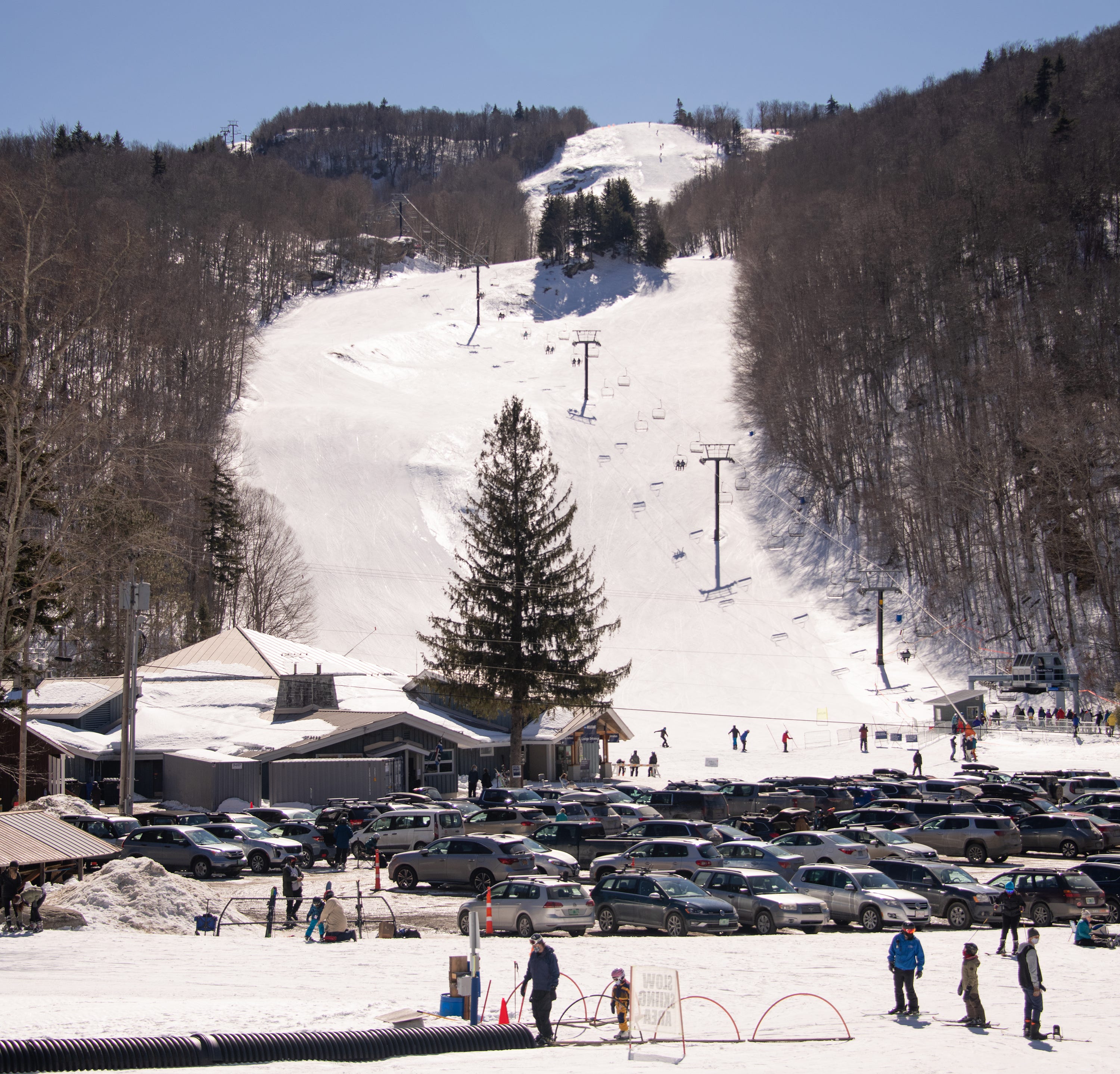
Why I thought that now was a good time for this interview
Suddenly, Middlebury is booming. Skier visits popped 20 percent this past winter, after soaring 60 percent during the 2021-22 ski season. And while the college still subsidizes ski area operations, management is reinvesting with the hopes of reaching self-sufficiency long term. This summer, Middlebury will install night-skiing and replace the Sheehan double with a brand-new Skytrac quad.
What’s going on? Why is a thousand-footer jammed between Killington and Sugarbush exploding? Wasn’t the Epkon Godzilla supposed to leave nothing but craters and a dozen super resorts as it bulldozed its way across New England?
Skiers seem to be telling us that there is room in the marketplace for a ski area that acts like ski areas did for 80 years. Before $200 lift tickets. Before Colorado HQ. Before checklist tourism. Before the social media flex. Before chairlifts could load the population of Delaware into a single carrier.
At Middlebury Snowbowl, a minivan filled with the six members of the Parker family of Hancock Vermont can roll into the parking lot on a weekend morning, pay rack rate for lift tickets, and ski all day without waiting in line. They can wander and explore and not get bored. Middlebury’s trail network is limited by big-mountain Vermont standards, but there’s plenty there. Especially if there’s snow on the ground and the Parker clan can handle some light trees. The place sprawls over hundreds of acres, deceptively large.
There’s a desire and a demand for places like Middlebury Snowbowl right now. For something easier and cleaner and cheaper. More atmosphere and less circus. A day on skis that’s just about the skiing.
What I got wrong
I described Vermont’s Act 250 as a state law that governs how ski areas can develop. That’s partially correct but somewhat misstates the purpose and intent of the law, which applies to land use and development as a whole across the state. From Vermont’s official Natural Resources Board website:
Act 250 (10 V.S.A. Chapter 151) is Vermont’s land use and development law, enacted in 1970 at a time when Vermont was undergoing significant development pressure. The law provides a public, quasi-judicial process for reviewing and managing the environmental, social and fiscal consequences of major subdivisions and developments in Vermont. It assures that larger developments compliment Vermont’s unique landscape, economy and community needs. …
The effects of Act 250 are most clear when one compares Vermont’s pristine landscape with most other states. Protecting Vermont’s environmental integrity and the strength of our communities benefits everyone, forming a strong basis for both our economy and our quality of life.
The Act 250 process balances environmental and community concerns; a tall order which at times can be complex. Developers, engineers and consultants best navigate the Act 250 process by planning their project, from the earliest stages, with the 10 criteria in mind.
As a result of Act 250 and the planning process, project designs, landscaping plans and color schemes fit the landscape. Act 250 has helped Vermont retain its unsurpassed scenic qualities while undergoing the substantial growth of the last 5 decades. Act 250 is also critical because it requires development to conform to municipal and regional plans and Vermont’s land use planning goals.
The Act 250 criteria have protected many important natural and cultural resources — water and air quality, wildlife habitat and agricultural soils (just to name a few) — that have long been valued by Vermonters and that are an important part of the state’s economy. No single law can protect all of Vermont’s unique attributes — but Act 250 plays a critical role in maintaining the quality of life that Vermonters enjoy.
The law, for all its benefits, is often viewed as a regulatory burden that considerably stunted the potential of Vermont’s ski areas over the long term. The late Chris Diamond examined the impacts of Act 250 at length in his book, Ski Inc. 2020:
In short order, the ski area operators became the bad guys, the most visible incarnation of the capitalist beast, to these newcomers [in the late ‘60s and early ‘70s]. Over time, the enmity – or, at a minimum, distrust – was formalized in a regulatory structure that made day-to-day business life incredibly difficult. Capitalism brings a certain messiness and unpredictability, something the new political majority would not tolerate. Vermont basically tried to have it both ways: a healthy economy and some of the nation’s most restrictive land-use laws. Given a ski area’s impact on the natural and social environment, they were disproportionately impacted. Water-quality regulations made it impossible or extraordinarily expensive to expand snowmaking operations. Other criteria under the state’s landmark environmental law, Act 250, were aimed at growth issues. The permitting process gave significant influence to those representing the status quo. So it shouldn’t be surprising to note that, generally, the status quo was protected. For most rural areas, that meant zero or slow growth. An unintended but inevitable result: As decades passed and people moved on, the population base began to shrink. …
My view is that the current situation would be less dire if the state’s ski communities were as economically vigorous as their Western counterparts. …
During the ‘90s, growth in most of Vermont’s ski towns ground to a halt. A notable exception was Okemo, where the Mueller family managed a significant terrain expansion, a second base area, and a related real-estate development. Although their operating competence and focus on service were largely the catalysts, they also benefited from their location in the former manufacturing-based economy of Ludlow. Here the status quo was arguably more focused on economic survival. The Muellers also proved themselves exceptionally skilled at navigating the permit process.
The bigger challenge for most Vermont resorts remained water for snowmaking. Most have finally managed to navigate their way to a solution and now offer a competitive product, albeit at great cost and with significant delays. (For Mount Snow that process took over 30 years). With that, and all the other changes that are occurring within the ski realm, I do believe they face a brighter future. Vermont ski towns will continue to evolve into important economic centers. But in my view, they will not be what they might have been.
Diamond was a smart guy, and ran Mount Snow and Steamboat over the course of several decades. Ski Inc. 2020 and its companion book, Ski Inc. are must-reads for anyone who enjoys this newsletter. But while I agree with much of Diamond’s analysis above, I floated this notion of Act 250-as-development killer to a prominent Vermont resort operator last year. That individual waved their hand toward the base area we were sitting in and the stacks of condos rolling up the hillside. “Well, we built all this,” they said. And Vermont does offer considerably more ski-in, ski-out accommodations than, say, New York. Killington is finally moving ahead with their base village, and the state is home to the best and most-advanced lift systems in the Northeast.
So something’s working there. The truth, as always, is probably somewhere in between the extremes of the build-it-all and build-nothing-at-all fundamentalists.
Why you should ski Middlebury Snowbowl
Every year, more megapasses move into the marketplace. But neither Vail nor Alterra has added a new ski area in the Northeast since Windham joined the Ikon Pass in 2020 (Seven Springs, which joined the Epic Pass in 2022, really serves the Mid-Atlantic and Midwest). It’s fair to assume that more skiers are trying to cram into an unchanging number of ski areas each season. And while the mountains can somewhat mitigate peak-day crowds with advanced reservations, lift-ticket limitations, and higher-capacity chairlifts, skiers also have a crowd-control mechanism at their disposal: go somewhere else.
Savvy Northeast skiers know how to people-dodge. Sure, go to Killington, Sugarbush, Stowe, Loon, and Cannon. They are all spectacular. But on weekends, unlatch the secret weapons on the ski-area utility belt: Plattekill, Berkshire East, Elk, Black Mountain in New Hampshire and Black Mountain of Maine. Excellent ski areas, all, lacking their competitors’ size and crowds but none of their thrill and muscle.
Middlebury Snowbowl belongs on this list. True, 1,000 feet of vert makes Middlebury the 16th-tallest ski area in the state of Vermont. And unlike people, the ski area can’t just buy a bigger pickup truck to compensate. But 1,000 vertical feet is a good ski run. Especially when it’s fed by 200 inches of average annual snowfall that doesn’t get shredded by Epkonitron hordes trampling off high-speed chairlifts.
At some point, each skier has to decide: will they ski the same dozen ski areas they’ve always skied and that everyone else they know has always skied, or will they roam a bit, taste test, see if they need that high-speed lift as much as they think you do. Or do they give that up – even if just for a day – to view the snow from a different angle?
Podcast Notes
On Vermont being a sparsely populated state
Despite its outsized presence in the U.S. ski industry – the state typically ranks fourth in skier visits behind Colorado, California, and Utah – Vermont is tiny by just about any measure. It’s the seventh-smallest U.S. state by size and the second-smallest by population, with around 650,000 residents (Wyoming is last with just 580,000). This surprised me, mostly because the state is so close to so many population centers (New England is home to nearly 15 million people; New York to another 20.5 million).
On the U.S. ski industry’s massive investment
Hussey and I briefly discuss the U.S. ski industry’s massive capital investment for this past season. The exact number was $812.4 million, according to the National Ski Areas Association.
On that punchcard
Middlebury Snowbowl offers one of the best season pass perks of any ski area in New England: each pass includes a punch card good for four lift tickets. This solves a season passholder’s greatest irritation: dragging along cheap-ass procrastinating friends who can’t be bothered to buy anything in advance but also don’t want to donate a lung to pay for a Saturday lift ticket. Or the friend who has an Ikon Pass and is horrified by the idea of paying for another day of skiing beyond that massive investment. The card is transferrable and has no blackouts.
On the Indy Pass Allied and XC programs
The Indy Pass has done a marvelous job adapting to a complex industry. This can be a bit confusing, as Hussey outlines in the podcast – some Indy Pass holders show up to Middlebury expecting “free”* lift tickets. But the ski area is part of the Allied Resorts program, which gets skiers half off on non-holiday weekdays, and 25 percent off at other times. I analyzed the Allied program at length here.
Lift tickets to Rickert Nordic Center, which Hussey also manages, are included on the Indy Pass and the drastically discounted Indy XC Pass. I discussed that pass here.
*Megapass lift tickets are also characterized as being “free,” but that is incorrect: the passholder paid for the pass in advance, and is simply redeeming a product they’ve pre-purchased.
The Storm publishes year-round, and guarantees 100 articles per year. This is article 49/100 in 2023, and number 435 since launching on Oct. 13, 2019. Want to send feedback? Reply to this email and I will answer (unless you sound insane, or, more likely, I just get busy). You can also email skiing@substack.com.



